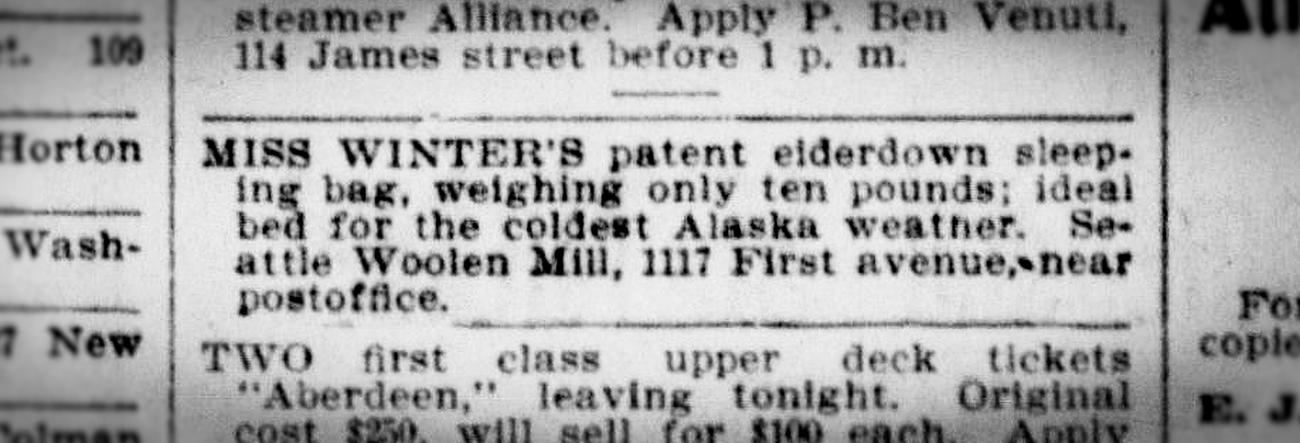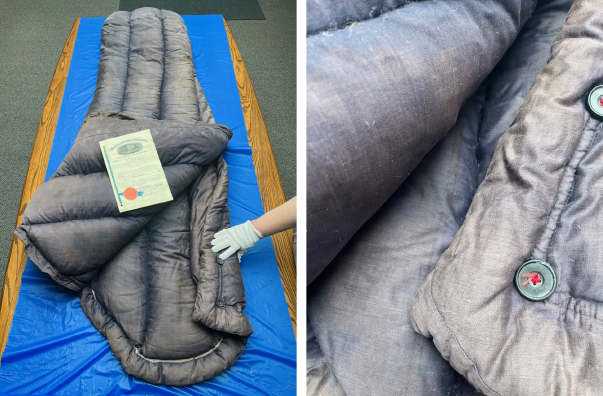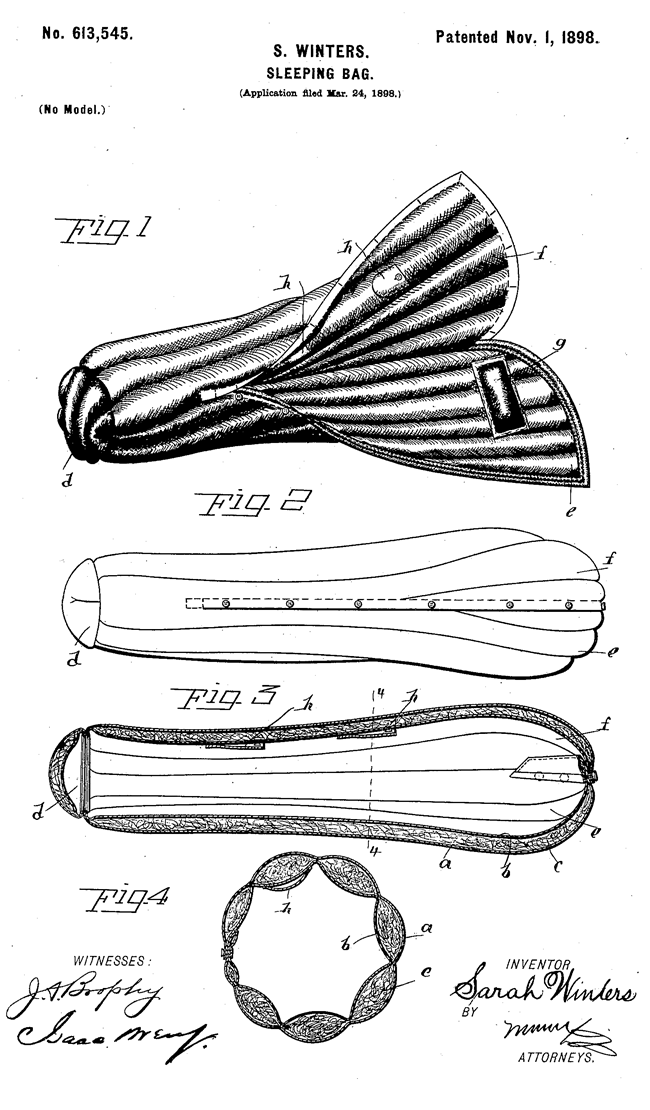Part of a series of articles titled Home and Homelands Exhibition: Work.
Previous: The Elizabeth Bacon Family House
Next: Celiast Smith
Article

Seattle Evening Post, May19, 1900
Over 70,000 people came through the port city of Seattle to buy essential goods before heading north to the gold fields of the Klondike Gold Rush.1 When searching the local newspapers for information about the latest goods, many prospectors likely came across the following advertisement: “Miss Winter’s patent eiderdown sleeping bag, weighing only ten pounds; ideal bed for the coldest Alaska weather. Seattle Woolen Mill, 1117 First avenue, near postoffice.”2
Considering the freezing temperatures and long trek ahead, Miss Winters’ innovative sleeping bag may have been at the top of a gold seeker’s list for goods to acquire. For the next several months, the sleeping bag would be their home, as most Klondike Gold Rush stampeders crossed either the challenging Chilkoot Trail or White Pass Trail to reach the gold fields in Canada’s Yukon Territory.

NPS Collections/KLSE
The most prevalent imagery of home in the American West is the rural farm homestead of a pioneer family. However, mineral rushes and their accompanying mining economies were crucial to the American conquest of the Pacific West. For those seeking their fortunes, home was something they left behind and sometimes the very reason for leaving in the first place – to strike it rich in order to build a better home for their family.3 However, in reality, they made homes on the move, in hotels, boarding houses, cabins, tents, and even sleeping bags, leaving their mark in the form of boomtowns everywhere they went.
Sarah Winters capitalized on these dreams of gold. While some women prospected and many more women provided the essential services that made mining economies run, Sarah stands out for inventing and patenting a product designed to assist Klondike gold seekers. At a time when women only accounted for 1% of U.S. patents, Sarah’s invention is striking, reflecting not just hard work but a spirit and practice of ingenuity that has been historically difficult for women to access.4

NPS Collections/KLSE 00025
Who was Sarah Winters and how did she come to patent a sleeping bag? Little is known about her beyond her patent file, but by tracing her steps in the census and other historical documents, her life begins to take shape.
Born sometime around 1857 to Irish parents who emigrated to Canada, Sarah arrived in Seattle in 1890.5 Located in the homelands of the Coast Salish Tribes, Seattle was a relatively new city when Sarah arrived, its population having increased an astonishing twelve fold over the previous decade. By 1891, Sarah had already established herself as a dressmaker according to the city directory.6
When first hundreds and then thousands of prospectors began streaming through Seattle in 1897, the single, forty-year old Sarah had an idea. Perhaps she saw the stampeders' need and realized she had the skills to help them. Or, maybe she was tired of living on the wages of a dressmaker and hoped she could strike it rich, or at least make a decent profit, from all the money suddenly funneling through her city.
What we do know for certain is that in 1898, Sarah Winters filed and was granted a patent for a sleeping bag of her creation. Klondike Gold Rush National Historical Park - Seattle holds the sleeping bag prototype and the original 1898 patent in their extensive collections.
The purpose Sarah stated for her invention was “to provide a cover for persons sleeping in arctic climates.” Made of cloth covering quilted eiderdown (goose or duck feathers), it also included interior pockets and flaps that could be fastened shut, completely enclosing the person. She claimed the user could still breathe through crevices and that it was almost waterproof and buoyant. Its construction and slight weight, she points out, meant it could be easily rolled and carried by a traveler.7

NPS Collections/KLSE
The modern sleeping bag was only about twenty years old when Sarah filed her patent during what is known as the “golden age of invention.”8 Certainly aware of these latest advancements in sleeping bag technology, Sarah specified her invention for the arctic conditions of the Klondike Gold Rush. In 1899, she was listed in the city directory for the first time as “dressmkr and mnfr sleeping bags.”9
While women have always invented, from 1865-1900 less than 1% of all patents were granted to women. Despite formal equality in the patent system, a number of factors prevented women from becoming patented inventors in the nineteenth century. These included limitations on married women’s ability to exploit patents and property rights; the difficulty of women accessing higher education, scientific training, and the business world; and cultural attitudes that frowned on women pursuing science and entrepreneurism. The world women lived in simply made it unlikely and difficult to translate the idea for an invention into a formal patent or a commercial product.10
Despite these barriers, Sarah succeeded in filing her patent. Considering she advertised for the product, she also might have found some success mass producing it. Her sleeping bag may have even proven to be a fundamental asset for some of those traveling to the gold fields. However, it is highly unlikely that Sarah made her fortune, or even much profit, from her invention considering both the obstacles women faced in becoming commercially successful at this time and what historical documents tell us about the remainder of her life.
In the 1900 city directory, she is listed as only a dressmaker again. In 1906, she married, and by 1910, she had one child and was keeping lodgers in a rented home with her husband. By 1920, she was divorced but now owned her own home. The census recorded that she had no occupation, but she continued to keep lodgers, presumably until her death in 1927.11 Running a private lodging house from one’s own home was one of the most common ways women made a living during this period.12 While Sarah’s remarkable invention and her final decades keeping lodgers may seem at odds, they share the common thread of providing makeshift homes in the worlds created by dreams of gold.
1 “History and Culture,” Klondike Gold Rush National Historical Park - Seattle Unit, National Park Service.
2 This advertisement ran for months, but for one example, see Seattle Post Intelligencer, May 11, 1900, 11.
3 For reading on the role of home in the lives of gold rushers, see Malcom J. Rohrbough, Days of Gold: The California Gold Rush and the American Nation (Berkeley: University of California Press, 1997); Susan Lee Johnson, Roaring Camp: The Social World of the California Gold Rush (New York: W.W. Norton, 2000); Brian Roberts, American Alchemy: The California Gold Rush and Middle-Class Culture (Chapel Hill: University of North Carolina Press, 2000).
4 Deborah J. Merritt, “Hypatia in the Patent Office: Women Inventors and the Law, 1865-1900,” The American Journal of Legal History 35, no. 3 (July, 1991): 289.
5 Depending on the historical document, her birth year ranged anywhere from 1852-1862. In the 1900 census, which records Sarah’s arrival date to the U.S. as 1890, her birth date is listed as 1862. See 1900 U.S. Census: Seattle Ward 2, King, Washington, roll 1744, page 17, enumeration district 0086.
6 “History and Culture.” Seattle, Washington, City Directory (Polk’s Seattle Directory Co., 1891), 852.
7 Sarah Winters, Sleeping-Bag, U.S. Patent US613545, filed March 24, 1898, and issued November 1, 1898.
8 Merritt, “Hypatia in the Patent Office,” 289.
9 Seattle, Washington, City Directory (Polk’s Seattle Directory Co., 1899), 1036.
10 Merritt, “Hypatia in the Patent Office,” 289, 299-300.
11 Seattle, Washington, City Directory (Polk’s Seattle Directory Co., 1900), 1102. Washington, County Marriages, 1855-2008. Salt Lake City, Utah: FamilySearch, 2013. 1910 U.S.Census, Seattle Ward 6, King, Washington, roll T624_1660, page 4b, enumeration district 0121. 1920 U.S. Census, Seattle, King, Washington, roll T625_1930, page: 6A, enumeration district 300. Sarah’s divorce is recorded in her 1927 death certificate, record 814, from Washington State Department of Health, State Death Records Index, 1907-1996, microfilm, Washington State Archives, Olympia, Washington.
12 For the prevalence and social and cultural importance of the boarding and lodging houses in the long nineteenth century, see Wendy Gamber, The Boardinghouse in Nineteenth-Century America (Baltimore: Johns Hopkins University Press, 2007).
Part of a series of articles titled Home and Homelands Exhibition: Work.
Previous: The Elizabeth Bacon Family House
Next: Celiast Smith
Last updated: November 14, 2025